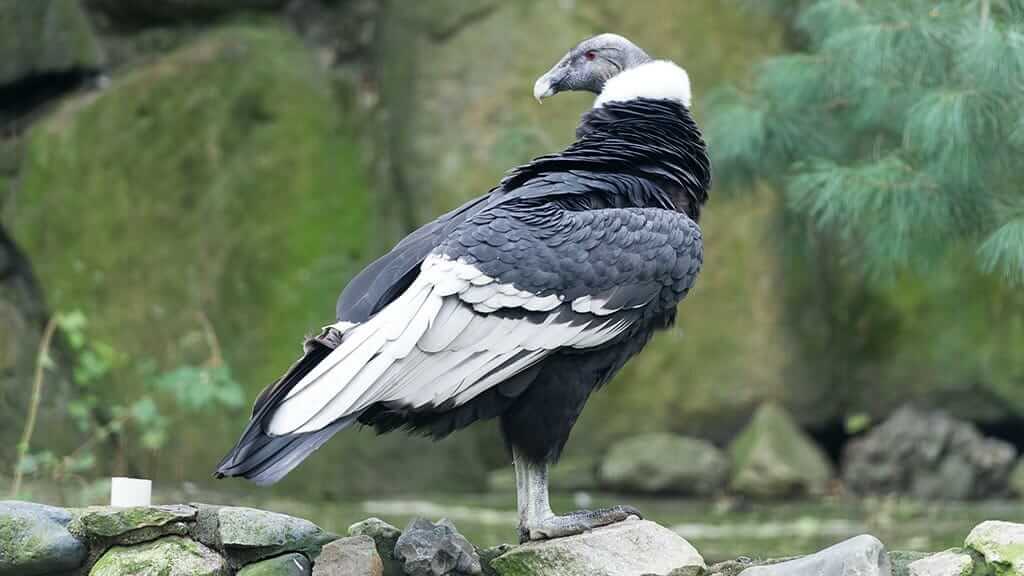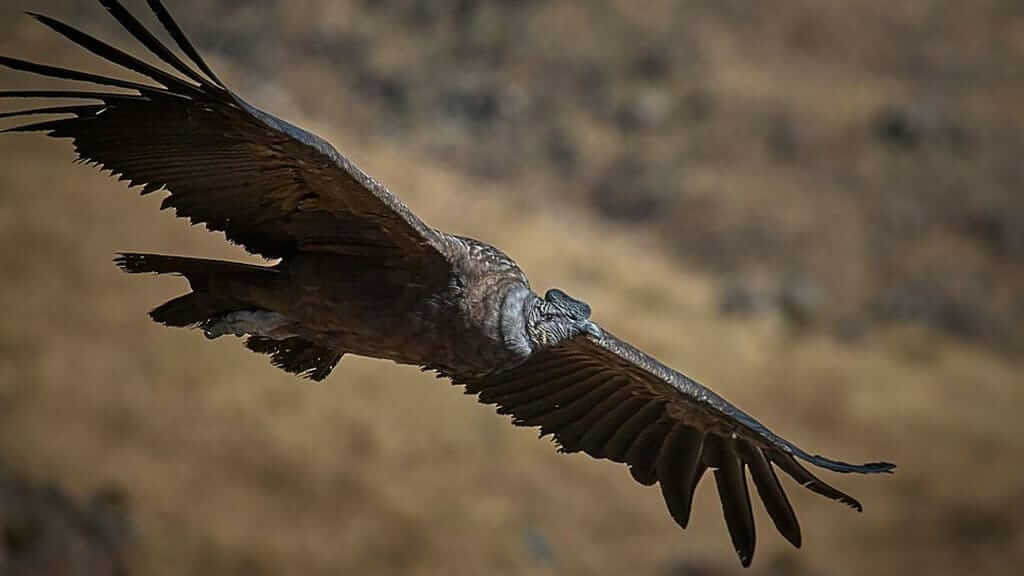Ecuador Condors
An Andean condor in flight is one of most magnificent sights in the bird world. When an Andean condor is gliding high up on the thermals, it is unmatched in grace and elegance. A moment of pure and effortless connection to nature. Past civilizations worshiped them, and modern tourist's jaws drop. The condor is clearly no ordinary bird.
Today there are fewer than 100 wild condors in Ecuador, yet it is not as hard to see them as you might imagine. So, read on to learn everything about Andean condors. Where and when can you see condors in Ecuador? What conservation work is underway to protect them? Plus heaps of other interesting Andean Condor facts.
SECURE YOUR ECUADOR TRAVEL
Get a FREE personalised quote todayAndean Condor Facts
Scientific Name: Vultur gryphus
Andean Condor Wingspan: Up to 3.3 meters (10.10 Ft)
Weight: 11-15 kilos for an adult male
Condor Life Span: 50 – 70 years
Habitat Range: They are found in Andean mountain ranges of Ecuador, Peru, Bolivia, Colombia, Argentina & Chile.
Plumage: Overall black coloring with tuft of white feathers at the neck, and white band on the wings.
The Andean Condor is the largest flying bird in the world, when measured by combination of weight and wingspan.
Condors typically nest on cliff ledges, where they can take advantage of updrafts of warm air to take off. Over 75% of their in flight wing movement takes place on the take-off phase. Once they are up and gliding, minimal effort or wing movement is required. Famous English botanist Charles Darwin notes having watched them fly for half an hour at a time without even once flapping their wings.
A recent study published by the National Academy of Science has uncovered even more incredible insights into the flying capability of the Andean Condor. A team of bird experts from several universities combined to co-author this unique study. Special equipment was strapped to the legs of 8 individual condors in Patagonia, to record their flight habits. Incredibly, results show that an Andean Condor on average flaps it’s wings just 1% of the time that it is airborne. So 99% of a condor’s flight time is spent effortlessly gliding. One condor in the study even flew a distance of 100 miles without flapping it’s wings once. So, the Andean Condor truly is King of the skies!
An individual condor may travel over 100km a day, searching for food. Andean condors are members of the vulture family. They scavenge for food, looking for carrion. In the wild condors usually look for large carcasses of deer, llama and alpaca. Or if close to inhabited areas they will eat dead cattle, sheep, donkey or any other carrion that is accessible.
Where to see an Andean Condor in Ecuador?
Today there are fewer than 100 wild Andean Ecuador Condors, and around 6,700 alive in the world. The International Union for the Conservation of Nature (IUCN) lists the Andean Condor on their red list as Near Threatened, with a declining population trend.
Yet there are still several excellent places to look for Ecuadorian condors. Their preferred habitat is high altitiude (over 5000 Ft), with access to rocky cliffs for safe nesting, and open grassland for spotting carrion. Many of Ecuador’s paramo highland national parks and reserves are just perfect. The vast majority of Ecuadors condors can be found in: Antisana Eco Reserve, Cotacachi-Cayapas Eco Reserve, Zuleta in Imbabura province, Cotopaxi National Park and El Cajas National Park.
Ecuador Condor watching at Antisana
The most reliable place to see wild Condors in Ecuador is at Antisana Eco Reserve. This is a protected area of andean moorlands, forest, lakes and volcanic lava flows and cliffs.
There is a lookout platform in front of Ecuadorian condor nest on cliff ledges. Bring strong binoculars or a zoom camera lens to see them. They can also quite often be spotted flying overhead in other parts of the reserve, searching for food. In total over 35 individual condors have been recorded in Antisana Reserve. Visitors do need patience and luck, but condor sightings are fairly common.
Antisana is easily accessible as a day trip from Quito with private transport. Happy Gringo operate an action-packed Antisana day tour with private guide. For birders this is a wonderful day out, with 60+ recorded species. Apart from the Andean Condor, other birds to look out for include: raptors, high altitude humming birds, Lapwings, Ibis, as well as ducks, coots, grebes and waders in the lake.
There is also plenty to see in Antisana Reserve for non birders. Large (but shy) mammals such as White-Tailed Deer, Andean Bears, and Puma also call the reserve home. Perhaps the biggest highlight is the stupenduous view of snow-capped Antisana Volcano on a clear day. There is also plenty of evidence of the immense lava flows that shaped the Antisana landscape.
GET FREE ADVICE
From an Ecuador destination expert todaySee condors at Parque Condor, Otavalo
For visitors who don't have time to head to Antisana, or don't have any luck there, try Parque Condor to see Andean Condors in captivity. Parque Condor is a rescue center for Andean raptors, giving them a suitable home where they are well looked after. They have a twice daily flight demonstration with hawks or falcons, as well as many displays.
Otavalo is another easy day visit from Quito, and can be combined with the famous Otavalo handicrafts market, Cuicocha Lagoon, Peguche Waterfall, or other local sites.
Quito zoo at Guayllabamba also have captive Andean Condors that are well looked after. They were also instrumental in rescuing a male condor that was in some trouble in April 2020. Iguiñaro had been shot by hunters, and was found in a badly wounded state. The zoo staff helped him to a full recovery, before releasing Iguiñaro into the nearby Chakana Reserve.
For more information about discovering the astounding natural beauty of Andean Condors in Ecuador, contact a member of our team to organise a day trip to Antisana Reserve, a specialist Ecuador birding tour, or custom made nature lovers vacataion.
The Andean Condor in Mythology
The Andean Condor has always had an important role to play in Ecuador’s culture and society. Today, the Condor is Ecuador’s national bird, proudly displayed on the flag and coat of arms as a symbol of bravery and power. Also historically Andean condors have been the inspiration for many legends.
The Incas believed that condors were the messengers of the gods. They would fly between heaven and earth, to keep the gods informed of what was going on below. It is certainly not hard to see why the magnificent Andean Condor, King of the skies, would be admired and worshiped in this way.
Condors were also thought to be able to morph into human form. On the Quilotoa Loop there is a famous legend of the Condor who fell in love. He falls for a local indigenous woman who works in the fields, and morphs into a man in poncho to woo her. At first the locals are angry, but eventually the couple are accepted and the woman changes into a beautiful female condor. Take a close look at the colorful local art at Tigua village. Images of the condor who fell in love are commonly depicted in local scenes around Quilotoa and Cotopaxi.
Condors have also featured on art and pottery from 2500BC, long before even the Inca empire and the Spanish.
In Ecuador Andean Condors are protected by law. But unfortunately this does not always stop them being targeted by local farmers who mistakenly blame condors for hunting livestock. In reality condors are part of the vulture family, so they scavenge rather than hunt. Yes, they will happily dine on a cattle or sheep carcass, but only when they are already dead. But the bad reputation has stuck. Educating local farmers is vital, and the threat of prison sentances and heavy fines act as a strong deterrent.
Species conservation begins with better understanding of current numbers and habits. However, counting condors is no easy task as they are rarely all in their nests at the same time. In September 2015, 163 volunteers in 11 provinces recorded a total of 93 Andean Condors in Ecuador during two days of observation. Gender, approximate age, movements, and habits were all noted. It’s now estimated that Ecuador’s total condor population is between 94 and 102, living in 70 roosts. This is roughly double the original estimate. Around 65% are adults, with 26 potential breeding pairs.
Ecuador Andean Condor Breeding Project
So what is actively being done to protect condors in Ecuador?
An interesting Condor Conservation & Breeding program has been set-up at Condor Huasi, Hacienda Zuleta. Their aim is to breed and raise Andean Condor chicks in captivity, before releasing them into the wild. They currently have 7 Condors in a large aviary, which can be visited by guests of the hacienda. But breeding condors in captivity is no easy challenge, so we'll have to wait and see if results are positive.
Another challenge to condor numbers in Ecuador is their mating behavior. Andean condors are monogamous, choosing one partner for life. So if a condor’s partner passes away, then it is very unlikely to be able to match it with a new mate. Their courtship and mating cycle is also longer than most species. Biologists believe it takes about two years from the time of courtship until a chick hatches from the egg. Usually just 1 or 2 eggs are layed in each nesting attempt. Baby condor hatchlings then need 6 months of care before they can fly, and another 3 months before fending for themselves. So condor population growth is always very challenging.
In other hopeful news, the Universidad San Francisco de Quito (USFQ) now has its first condor egg incubator, which will hopefully put Ecuador’s most emblematic species out of serious danger of extinction. There are only two condor couples in captivity that have produced eggs: Kawsay & Auki have had six offspring at the Quito Zoo in Guayllabamba. Two of the offspring are expected to be released soon.
Book With The #1 Trusted
Ecuador Travel Agency
In conclusion, there are still Andean condors in Ecuador, alive and well. It is also possible for tourists to see them, either in the wild or in captivity. The Ecuador condor is a magnificent bird, so if you do have the opportunity to visit Antisana Reserve then it is highly recommended. Truly nothing compares to witnessing a huge Andean condor soaring majestically in the skies!






